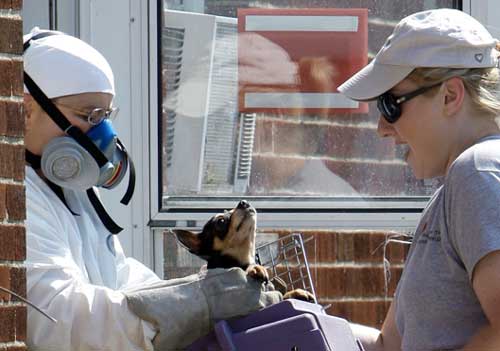Frankie (above and at left) was one of 112 filth-covered chihuahuas rescued in July 2009 from Kenneth Lang, Jr.'s "House of Horrors" in Detroit, Michigan, where an additional 150+ chihuahuas were found dead.
 The rescuers and clean-up teams had to wear hazmat outfits. Clean-up of garbage, feces, and urine amidst hundreds of hoarded broken computers and television sets, cost the city $37,000. The rescuers and clean-up teams had to wear hazmat outfits. Clean-up of garbage, feces, and urine amidst hundreds of hoarded broken computers and television sets, cost the city $37,000.
More dogs were being found still living amidst the filth and accumulation after days of hauling and searching. The house itself was found to be no longer habitable, was condemned, and slated for demolition; in April 2010 the bulldozers arrived to smash the fecally infused building into a pile.
Some of the dogs had been kept in tupperware containers without food or water. Many were emaciated or had already dehydrated or starved to death.
In the basement were banks of freezers in which Lang kept many of the dogs that hhhhad died. Hoarding of cats or dogs as well as trash is a commonly encountered disorder, but Lang added somethinng of a filip to the disorder by his inablity to part with animals even after they were dead.
Of the hundred-twelve survivors, Elaine Greene of the Dearborn Animal Shelter said many of these dogs were in the worst condition ever seen, and many might forever after be special needs animals. Some of them were exceedingly friendly despite the conditions they were kept in. Others were clearly traumatized and getting them to become tame and friendly would prove an ordeal.
 The 56 year old man insisted he meant no harm and loved the chihuahuas. The 56 year old man insisted he meant no harm and loved the chihuahuas.
He was allegedly mentally retarded, and more certainly suffered from a obsessive-compulsive disorder. By court order he was placed in a group home at an undisclosed location. Though he was given five years probation in a mental health program, and ordered to pay $60,000 restitution which would only partially cover demolition of the house and care of his animal victims, though it was unclear how he could ever pay for anything at all.
Tempting though it is to imagine Lang was not responsible for his actions due to mental illness, it seems he was more than clever enough keeping the neighbors from learning of his endeavors, for he kept the outside front of his house tidy though never the inside, giving a sidewalk impression of normalcy.
And so that neighbors would not smell the feces and corpses, he'd duct-taped doors and window edges.
Mr. Lang had not been known to take any dog to any veterinarian since 2003. Wayne County Prosecutor Kym Worthy has said Lang's actions were deliberate. She said, "These dogs died from emaciation, poor nutrition, dehydration and severe puncture wounds, and there were signs of post-mortem cannibalization. Some of the dogs appeared to have been euthanized via an injection to their hearts."
Once the plight of the dogs was discovered, Lang was sent to a psychiatric hospital for evaluation, then placed in a group home where he could himself be cared for and have his chihuahua-hoarding OCD behavior held in check. Meanwhile, hundreds of people came forth eager to adopt chihuahua survivors, and the shelter was able to place most of the dogs in good homes.
The photos at right show two more survivors of the ordeal, with an inset of Lang at his trial. Early in 2010, it having been assessed by mental health professionals that he did know right from wrong and could stand trial for multiple acounts of abuse of animals, Lang was found guilty, placed on five years probation, with a court order to never again keep animals.
Nine months later, 95 of the dogs had been placed in homes, a few left over with continuing health and behavior issues. It was expected that eventually they would all be in good homes.
Some of these photos are by
Paul Sancya and Tammie Denski.



|

